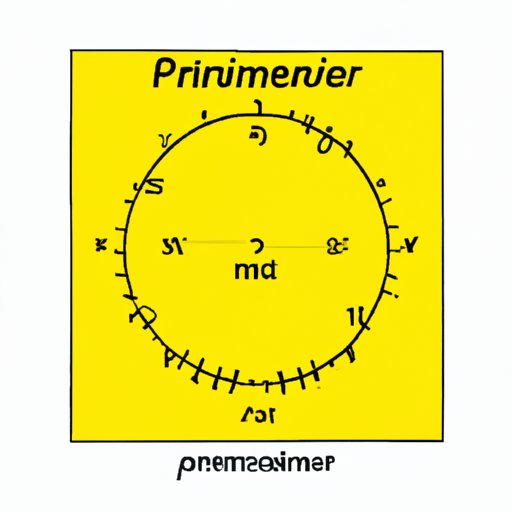
I. Introduction
Have you ever wondered how to calculate the outer boundary of a circle? Well, the perimeter of a circle can be a crucial aspect of geometry and mathematics. It is useful for architects, engineers, designers, and even bakers. Finding the perimeter of a circle is a fundamental concept that is imperative for anyone studying geometry or any math-related field. This article aims to guide beginners on how to find the perimeter of a circle, including using mathematical formulas and visual approaches.
II. Mathematical Formula
The perimeter of a circle can be determined using a simple formula: C = 2πr. This formula states that the perimeter (C) of a circle is equal to two times pi (2π) multiplied by the radius (r) of the circle.
To use this formula effectively, follow these simple steps:
- Measure the radius of the circle
- Multiply the radius by 2π (pi equals approximately 3.14)
- The result is the perimeter of the circle
For example, if the radius of a circle is 5 cm, we can calculate the perimeter using the formula C = 2πr, as follows:
- Measure the radius of the circle (r) = 5 cm
- Multiply the radius by 2π (2 x 3.14 x 5) = 31.4 cm
- The perimeter of the circle (C) = 31.4 cm
III. Visual Approach
Many people find it easier to understand mathematical concepts through visual approaches. For finding the perimeter of a circle, two-dimensional images and diagrams can help represent a circle in a more comprehensive way.
Visual approaches can be achieved by mapping out the circle’s dimensions on a piece of paper or creating a digital image using various software programs. With this approach, the circumference of a circle can be calculated by measuring the diameter of the circle (the distance across the circle passing through the center) and multiplying it by pi.
For example, if the diameter of a circle is 8cm, we can calculate the perimeter of the circle as follows:
- Measure the diameter of the circle (d) = 8 cm
- Multiply the diameter by pi (3.14 x 8) = 25.12 cm
- The perimeter of the circle (C) = 25.12 cm
IV. Real-Life Applications
The perimeter of a circle is essential in real life, with applications in various fields. In architecture, circles are used in designing round buildings such as stadiums or arenas. Engineers use circles in designing machinery, gears, and rotating engines. In baking, the perimeter of a circular pan can help determine the amount of frosting needed for a cake.
For example, suppose you want to decorate a 9-inch circular cake with frosting. In that case, you can use the perimeter formula to determine the amount of frosting needed. The perimeter of the cake is calculated as:
- Measure the diameter of the circle (d) = 9 inches
- Multiply the diameter by pi (3.14 x 9) = 28.26 inches
- The perimeter of the circle (C) = 28.26 inches
Knowing the perimeter of the cake, you can easily determine the amount of frosting required.
V. Historical Context
Circles have been an essential part of mathematics since ancient times. The perimeter of a circle has been and continues to be a fundamental concept in geometry and mathematics.
The ancient Egyptians and Greeks were the first cultures to use circles in their architectural designs, sculptures, and other mathematical concepts. For example, Archimedes, a Greek mathematician, found formulas for finding the area and perimeter of a circle, connecting circles with the concepts of pi and trigonometry.
VI. Comparison with Other Shapes
Unlike other geometric shapes, calculating the perimeter of the circle is unique. For squares, each side is equal, and to find the perimeter, it is merely a matter of adding up all the sides. In comparison, rectangles have two sets of sides with equal widths. To calculate the perimeter of a rectangle, add up the lengths of all four sides.
In a triangle, you add up all the sides, and a parallelogram includes two sets of sides parallel to each other. The perimeter is found by adding the lengths of all four sides. However, for circles, finding the perimeter is done through the mathematical formula or visual approach.
VII. Conclusion
Learning how to find the perimeter of a circle is essential, especially for anyone studying geometry or working in a math-related field. One method is through the mathematical formula (C = 2πr), while the visual approach can be achieved by creating a 2D image or diagram to represent the circle’s dimensions. With the importance of circles in various fields such as architecture, engineering and baking, knowing how to find the perimeter of a circle can be helpful in practical applications.
Keep in mind that circles have been an essential concept in mathematics for centuries, and understanding the history can provide a context for why finding the perimeter of a circle is significant. Last but not least, not all shapes are created equal, and finding the perimeter of a circle differs from other geometric shapes.
Remembering these methods and the importance of finding the perimeter of a circle can assist anyone working with circles or any geometric shape. By following these tips and advice, finding the perimeter of a circle can be efficient and straightforward.





